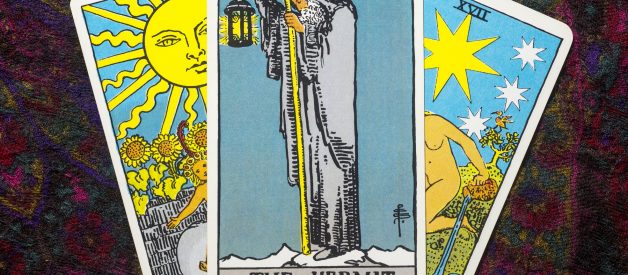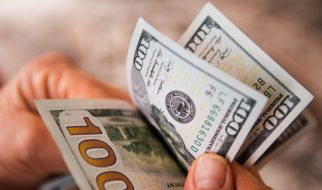The major arcana represent life, death, and rebirth. They also look completely insane.
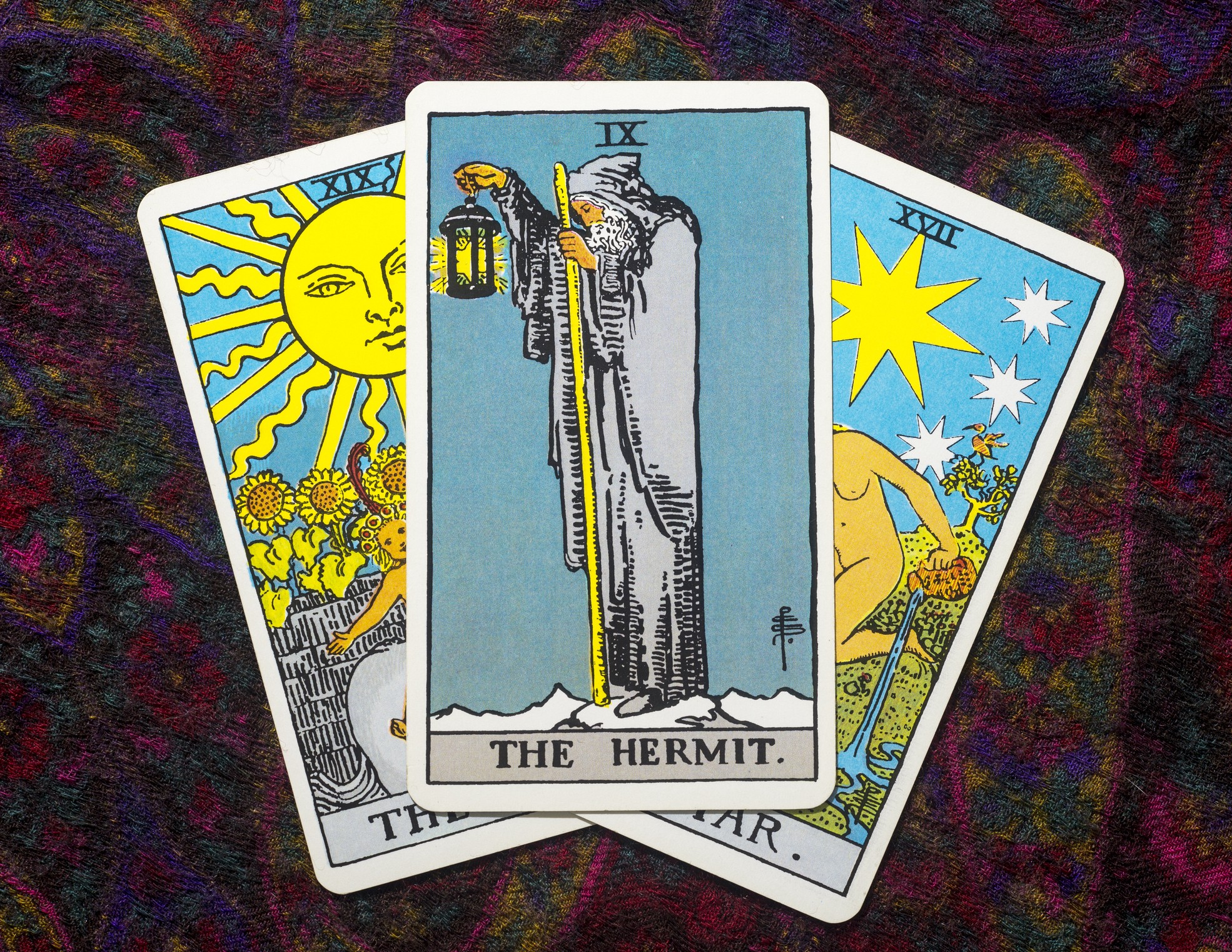 Photo: bigjom/Getty Images
Photo: bigjom/Getty Images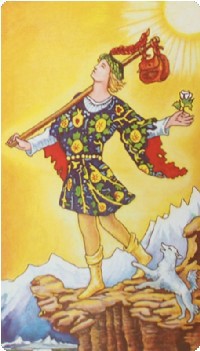
1. The Fool
The Fool is traditionally both the first and the last card of the major arcana. In fact, the major arcana cards together comprise the Fool?s journey through life. The Fool represents new beginnings, excitement, courage, and potential.
The Fool is also full of advice that wouldn?t look out of place stenciled onto a lime-washed board and sold at a Hobby Lobby, things like ?Believe in yourself and follow your heart? and ?Have faith in where the universe is taking you.?
Like that one aunt, ?the Fool is all about new experiences [and] personal growth.? He is also a little pouty and appears to have been captured in the middle of saying, ?It?s their loss!? The Fool has very fine bone structure.
The little, white, prancing dog at his feet is supposed to represent a ?protector,? though it?s unclear from what, if anything, a nine-pound dog is qualified to protect you. ?All the tools and resources he needs? for this trip are packed into a bindle the size of a bento box. He?s wearing yellow slouch boots and carrying a single white rose ? it?s like he used Goop to outfit an Everest ascent.
The Fool represents innocence, a kind word for stupidity. ?He does not seem to mind if he does not really know what lies ahead,? which sounds like a really passive-aggressive thing to write in someone?s yearbook.
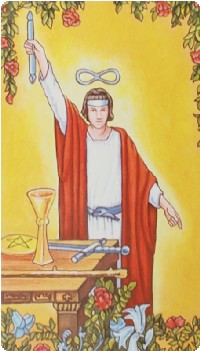
2. The Magician
The Magician (whose more metal name is The Magus) is the first card of the major arcana. The Magician also symbolizes fresh starts and new beginnings, because 100% of people who ask for a tarot reading want a new beginning.
The Magician is driven and goal-oriented. He can ?apply skill and initiative to accomplish all [his] goals.? His description reads like a performance review. He?s also wearing a snake for a belt.
The Magician card is holding a symbolic staff and making a symbolic hand gesture. He is holding symbolic tablets, wearing a symbolic robe, and standing hip-deep in symbolic flowers. Above his head floats the symbol for infinity. The Magician is like a junior-high essay on The Scarlet Letter.

3. The High Priestess
The High Priestess ?sits at the gate before the great Mystery? and ?in front of the thin veil of awareness, which is all that separates us from our inner selves.?
If you?re the kind of person who?s into tarot, you are the kind of person who wants to draw the High Priestess card. On a ?What tarot card are you?? quiz, the High Priestess is the card everyone wants to get. The High Priestess is the Elizabeth Bennet of tarot cards.
Moreover, her message is ?trust your inner voice,? which is a message absolutely everyone wants to hear. No one goes to a tarot reader to be told their instincts are totally wrong. A tarot reader?s primary job is to be an enabler ? in your heart, you already know you?re going to quit your job to be a yoga teacher, you just want someone to tell you that teaching yoga is your destiny.
?Knowledge of how to fix [your problem] will not come through logic or intellect but through your intuition,? she says, which is a real load off for people not overly gifted with logic or intellect.
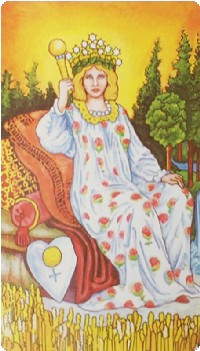
4. The Empress
The card of feminine energy, the Empress represents fertility, beauty, and abundance. She may indicate either a physical or metaphorical pregnancy, which seems like something you should really nail down.
The Empress wears a boldly patterned caftan she picked up in Yucca Valley. She?s sitting on a red velvet chair that looks like she found it on the sidewalk and tried to reupholster it herself. The Empress definitely uses the DivaCup.

5. The Emperor
The Emperor is the patriarch, the masculine seat of authority and power. The Emperor is paired with the Empress, even though he?s clearly at least 30 years older than she is. His expression is both scornful and wary, and he seems to suffer from mild rosacea.
The Emperor is seated on a throne ?decorated with four rams? heads, representing intellectual heights, determination, action, initiative, and leadership.? It is not at all obvious why rams? heads should represent these things, and the last three sound like they were borrowed from Six Sigma.
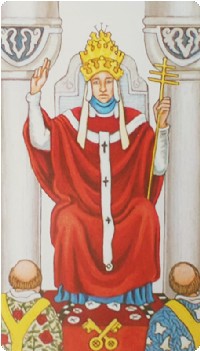
6. The Hierophant
The staid male counterpart to the much more fabulous Priestess card, the Hierophant represents institutional authority and established traditions. Like the Priestess, he is a religious figure, but in a much more orthodox setting.
No one is ever excited about getting the Hierophant, the middle-school principal of tarot cards. If you were the kind of person who got excited about orthodox religious authority, you likely wouldn?t be getting your tarot read in the first place.
Moreover, the Hierophant offers good, boring advice, like ?follow due process and to stay within the conventional bounds of what is typically an orthodox approach. Instead of being innovative, you will need to adapt to the existing set of beliefs and systems that are already in place. You will need to do what is expected of you.?
But the Hierophant is not all bad. The card can also represent a wise mentor, someone like a priest, boss, or teacher. It also may represent a gateway to higher consciousness, as does?without exception?every other tarot card.
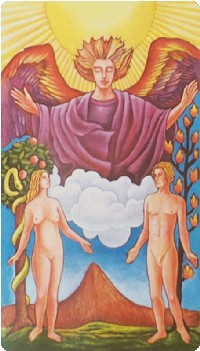
7. The Lovers
The Lovers card represents love, of course, and of the most rarified kind. The lovers share the deep emotional, physical, and spiritual connection you could expect from the kind of couple who calls themselves ?lovers.? The two lovers stand among symbols of fertility and intimacy. The woman is gazing at the giant flaming angel in the sky, and the man is gazing at the woman?s pelvis.
The Lovers card also represents a crossroads, and the need to make a decision. ?Unlike the Fool?s choice which has no wrong answer, the choice of the Lovers is very much right or wrong.? What?s more, ?these decisions or choices are incredibly important and significant so it is essential that you choose the right path.? No pressure.
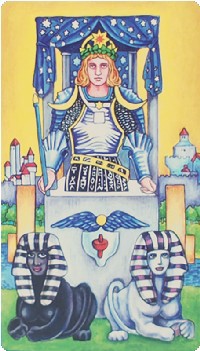
8. The Chariot
The Chariot represents will power, control, self-assertion, and victory. Also, in a refreshingly literal twist, the Chariot can represent driving. The card is a real grab bag of mystical symbolism, including stars, moons, alchemical symbols, and two extremely irritated sphinxes, the leftmost of which is actually rolling its eyes in disgust.
Everything the Chariot says, you can imagine being shouted through a megaphone: ?This struggle will ultimately make you stronger!? ?Get in the race and win it!? ?You have to dominate and beat the competition!? ?Assert yourself and be bold!? ?Pick up those knees!?
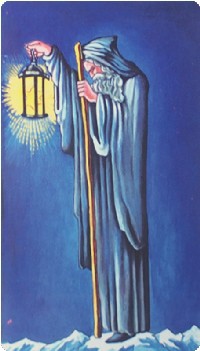
9. The Hermit
The Hermit looks like a thinner, tanner Gandalf. He wears the gray cloak of invisibility. Having reached the snowy summit of his harrowing spiritual quest, he now looks sad and a little sleepy.
The Hermit represents being single and loving it. ?Be content with being alone or associate only with those on your level,? the Hermit says emphatically over brunch. ?Do not waste time and energy on those not ready or not worthy.? (cough, Brian) The Hermit is constantly posting about introverts on social media.
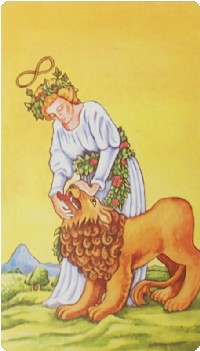
10. Strength
?The Strength Tarot card represents strength,? a popular tarot site helpfully explains, but unlike the amped-up jock jam sloganeering of the Chariot, Strength here means inner strength of character.
Strength is personified by a lovely woman wearing a long white dress wreathed in flowers giving a lion a comprehensive dental exam in what is surely a very specific fetish. ?This lion is happy to submit and surrender to the woman,? who has tamed him with her strength of will and really on-point eyebrows.
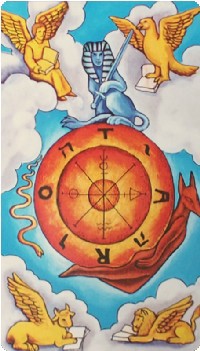
11. The Wheel of Fortune
The Wheel of Fortune represents life?s inherently cyclical nature. Sometimes things will go well, other times badly, but in the end, balance will be restored. The Wheel also represents karma, as well as fate and the external forces that control our destinies.
The Wheel of Fortune has absolutely everything you want in a tarot card, including an angel, a lion, a bull, a snake, a sphinx, esoteric letters and symbols from several major world religions, and an eagle that looks like the artist started out trying to draw one thing and then changed their mind halfway through.
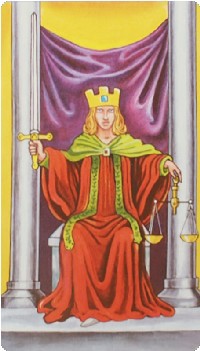
12. Justice
The Justice card represents justice, as one might expect, and more sternly, the idea that one gets what they deserve. Justice is all about taking responsibility for one?s self, and she gets a little blame-y: ?Your decisions and actions have long-term consequences and your present and future circumstances are most likely a result of these decisions and actions.?
Lady Justice sits on a throne, holding in one hand a double-edged sword and in the other, a set of scales. She looks stern and unbending. ?A little white shoe pops out from beneath her cloak, reminding us of the spiritual consequences of our actions,? reads a note as charming as it is inexplicable.
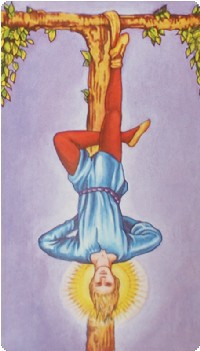
13. The Hanged Man
Like the Death card, the Hanged Man sounds much worse than it is. The card represents surrender: The man is described as a ?willing martyr,? someone who sacrifices himself to a greater cause. The Hanged Man also represents a period of watchful waiting, and he is doing that waiting upside down.
The Hanged Man is suspended from the world tree, and ?given the serene expression on his face, it is believed he is hanging on the tree of his own will.? (Really?) He may represent ?letting go,? a thing you absolutely should not do when hanging upside down from a tree.
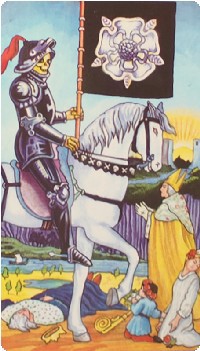
14. Death
Books that teach tarot reading advise readers to preface the revealing of the Death card with some variant of, ?Now don?t freak out?? In fact, the Death card usually symbolizes a time of change, where one door closes and another opens. This can be a very positive thing, a time of renewal and new beginnings. Then again, sometimes the card symbolizes death.
Death here is a skeleton wearing a suit of armor that indicates death?s invincibility. He is riding a horse with a very small head and red eyes. A collection of disproportionately small people bow before Death?s inevitable slaughter as he regards them with a goofy grin.

15. Temperance
The Temperance card signifies calm, balance, tranquility, and avoiding extremes. Temperance is cautious, keeping one foot on dry land.
In her hands she holds two cups of water, one hot and one cold, creating that mystical symbol of cosmic balance, tepid water. Supposedly, the water she is pouring is actually flowing backward, from the lower cup to the upper one, though it?s impossible to verify that.
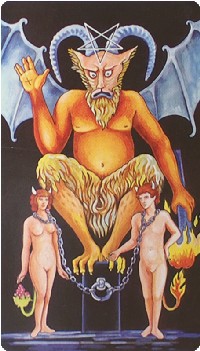
16. The Devil
Unlike the Death card, which seems bad but is good, the Devil card seems bad and is bad. The Devil represents materialism, vice, and addiction. He controls our lowest, most animal desires. At his feet, a man and a woman are chained, in servitude to their baser nature. However, the chains are loose and they could slip their heads from them if they tried, indicating that their bondage is voluntary.
The Devil is more disappointed than terrifying, and his satanic hand gesture is a dispirited wave. The chained lovers at his feet look dopey and complacent, gesturing toward the inky cave of the insatiable unconscious like it?s a showcase on The Price Is Right.
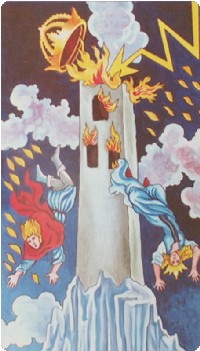
17. The Tower
Following on Death and the Devil, the Tower is a very bad card. It symbolizes sudden catastrophe. After this time of chaos, new and better things may emerge, but that?s likely small consolation during your current era of unremitting disaster.
The Tower is a sturdy-looking building that probably seemed safe, but now it has been struck by lightning and it?s on fire, and the same lovers who were so dreamily enraptured on the Lovers card and so calmly drugged out when chained to the Devil are now plunging headlong to their ruin amid 22 symbolic flames. The man?s mouth is open with surprise, while the woman is pursed in anger, as if to say, ?I warned you about the lightning.?
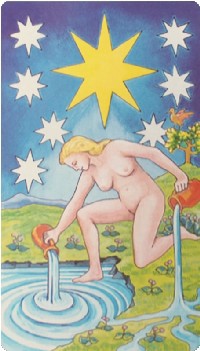
18. The Star
After the destruction of the Tower, the Star is all love and light. The card represents joy, kindness, hope, and faith ? basically anything you?d want to embroider on a tea towel.
On the Star card, a naked woman is serenely pouring water from a clear, still pool onto the grass, where it runs off in five streams said to represent the senses. The woman is pretty but in an approachable way. Behind her is a field of stars and a tree in which roosts the sacred (if extremely crudely drawn) ?ibis of thought.?
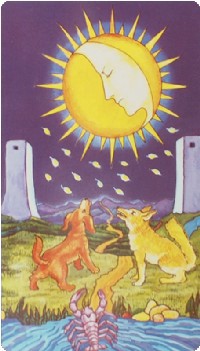
19. The Moon
One might assume the Moon would be a good card, suggesting femininity, fertility, and other mystically significant things, but in fact, the Moon is a mixed bag at best. The card represents intuition, but also subconscious fears and dark impulses. The Moon is associated with the eerie, mysterious elements of our unconscious minds, including recovered memories and nightmares.
The moon itself is upstaged by all the weird animals that are roaming around beneath it. A lobster crawls out of the depths of a dark pool, symbolizing the disturbing images that bubble up from our unconscious minds, and joins two dogs baying at the moon (some interpret these canines to be one dog and one wolf). Beyond the animals is a narrow path between two desolate towers. The moon wears the expression of someone who has just said their final word of an argument in bed and is now pretending to be asleep.
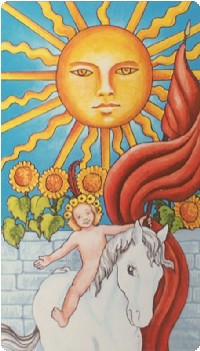
20. The Sun
The Sun is everything the Moon is not: open, positive, upbeat. Whereas the Star is serene and blissful, the Sun is way too chipper. The Sun played ?Get Lucky? at his wedding. The Sun cheers for the kiss cam. The Sun likes to shout ?I can?t hear you!? from the stage. The Sun means well, but all the other cards are embarrassed for him.
On the tarot card, the Sun itself looks a little embarrassed, pointedly averting his eyes from the spectacle below him: A naked, wreathed baby riding a white horse in front of a field of sunflowers, like the result of a dangerously escalating feud between Mary Engelbreit and Anne Geddes.
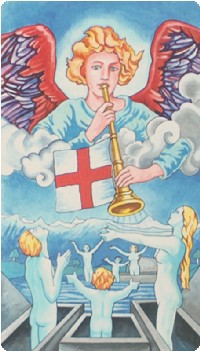
21. The Judgment
The Judgment card means judgment, not surprisingly, but also an inner voice, sudden realization, or higher calling. Judgment is about resolution, the cathartic climax to all of your struggles. The Judgment card also looks absolutely crazy.
The card shows a group of pallid, naked people rising up from their graves in a colorless, blasted landscape to the call of a trumpeting angel. The angel appears to be faking playing the trumpet, and not even faking it well. He holds the instrument stiffly while pointedly avoiding eye contact with the zombie cult members whose arms are upraised in worship of him.

22. The World
The World is the last card of the major arcana, and represents the summation of the journey begun by the Fool. After all the adventures of the past 21 cards, the World represents accomplishment, closure, and completion.
Unfortunately, the last card of the soul?s journey is also a bit of a mess. When you hear the phrase ?the world,? many images may come to mind, but one them is probably not a dancing lady wrapped in a purple shawl, holding a baton in each hand, and surrounded by a lion, a bull, an eagle, and a human figure described as a ?cherub? though he looks at least 28. The lady looks a little off-balance and more than a little drunk, which is perhaps not such a bad symbol for closure after all.
